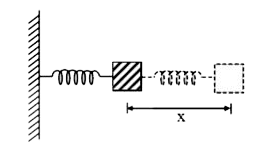The motion of a mass on a spring, with spring constant K is as shown in figure

The equation of motion is given by x(t) =Asinωt+Bcosωt with ω=√Km
Suppose that at time t = 0, the position of mass is x(0) and velocity v (0), then its displacement can also be represented as x(t) = Ccos(ωt−ϕ) , where C and ϕ are :
C=√2v(0)2ω2+x(0)2,ϕ=tan−1(v(0)x(0)(ω))
C=√2v(0)2ω2+x(0)2,ϕ=tan−1(x(0)ω2v(0))
C=√v(0)2ω2+x(0)2,ϕ=tan−1(x(0)ωv(0))
C=√v(0)2ω2+x(0)2,ϕ=tan−1(v(0)x(0)ω)
Step by step video & image solution for The motion of a mass on a spring, with spring constant K is as shown in figure The equation of motion is given by x(t) = A sin omegat + B cos omegat with omega=sqrt(K/m) Suppose that at time t = 0, the position of mass is x(0) and velocity v (0), then its displacement can also be represented as x(t) = Ccos(omegat -phi) , where C and phi are : by Physics experts to help you in doubts & scoring excellent marks in Class 12 exams.
Topper's Solved these Questions
- BOOK - JEE MAINS PREVIOUS YEARCHAPTER - JEE MAINS 2021EXERCISE - PHYSICS (SECTION-B)40videos
JEE MAINS 2021
- BOOK - JEE MAINS PREVIOUS YEARCHAPTER - JEE MAINS 2021EXERCISE - PHYSICS (SECTION - A)40videos
JEE MAINS 2021
- BOOK - JEE MAINS PREVIOUS YEARCHAPTER - JEE MAINS 2020EXERCISE - PHYSICS246videos
JEE MAINS 2020
- BOOK - JEE MAINS PREVIOUS YEARCHAPTER - JEE MAINS 2022EXERCISE - PHYSICS (SECTION -B)10videos
JEE MAINS 2022
Similar Questions
Knowledge Check
- Question 1 - Select One
The motion of a particle is given by x=Asinωt+Bcosωt. The motion of the particle is
Anot simple harmonicBsimple harmonic with amplitude A + BCsimple harmonic with amplitude (A+B)2Dsimple harmonic with amplitude √A2+B2 - Question 2 - Select One
The motion of a particle is given by x=Asinωt+Bosωt. The motion of the particle is
Anot simple harmonicBsimple harmonic with amplitude A+BCsimple harmonic with amplitude (A+B2)Dsimple harmonic with amplitude √A2+B2 - Question 3 - Select One
The motion of a particle is given by x=Asinωt+Bcosωt. The motion of the particle is
Anot simple harmonicBSHM with amplitude A+BCSHM with amplitude (A+B)/2DSHM with amplitude √(A2+B2)
The displacemeent of a particle is given at time t by x=Asin(−2ωt)+Bsin2ωt. Then,
View SolutionA simple harmonic motion is represented by x(t)=sin2ωt−2cos2ωt. The angular frequency of oscillation is given by
View SolutionThe displacement of a particle executing simple harmonic motion is given by y=A0+Asinωt+Bcosωt. Then the amplitude of its oscillation is given by
View SolutionThe displacement of a particle executing a S.H.M. is given by x= A "sin" ωt+Acosωt. What is the amplitude of motion ?
View SolutionThe displacement s of a particle at time t is given by s=αsinωt+βcosωt then acceleration at time t is
View Solution

